What Should We Call You? What (Almost) Everyone Gets Wrong About Names

Last year, I signed up to become a member of a coworking space that I planned to work from a few days per week. I intentionally signed up with my first initial and last name — because while I don't use my full legal name on a regular basis, I'll tolerate my first initial in mainstream/corporate environments.
When they sent me my login credentials, I saw that they had created a username in the form of [firstname_lastname] — using a first name that I'd never disclosed.
I'm still not 100% sure where they got it from: my billing details? My Australian business records? Public records associated with my phone number?
Regardless, it was creepy and unpleasant, and not how I wanted to be addressed in emails and other communications. When I asked them to update my username to my preferred name, there were ... complications. The system wasn't built for it.
I ended my membership after the first month.
What's In a Name?
For anyone who goes by a name other than the one they were assigned at birth, experiences like these can range from unpleasant to deeply traumatic.
According to a YouGov poll, many people prefer to go by a name that differs from their legal name: 23% of people go by a nickname, while others “go by a name based on their initials (4%), their middle name (4%), or a different name not assigned at birth (5%).”*
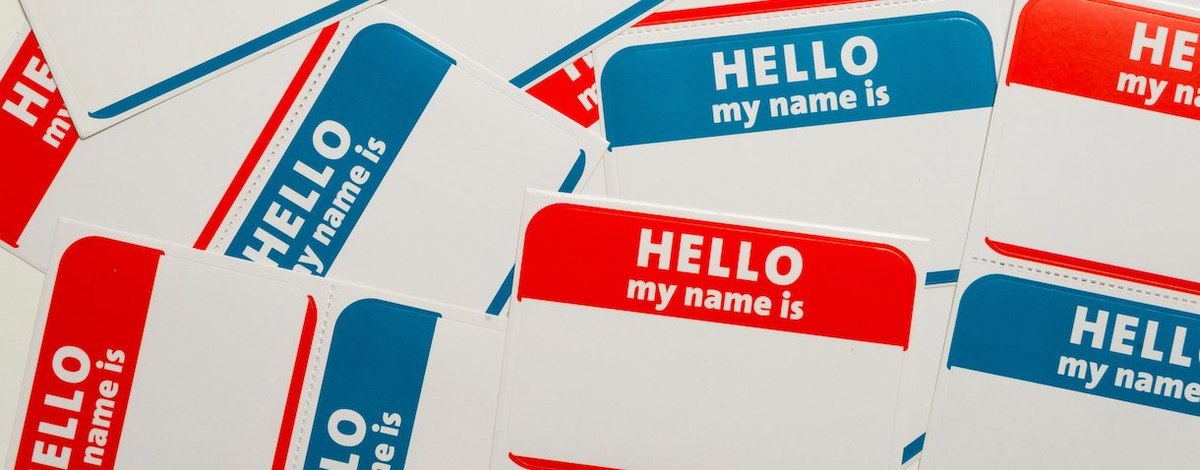
For some people, the name they use on a daily basis is a preferred name that they use alongside their legal name — both names are valid in different contexts. For others — especially queer and trans people — it's a chosen name that has fully replaced their birth name (often referred to as a deadname).
For the purposes of this article, we'll be covering several different kinds of names, but it's important to note that a person's real name is whatever they want to be called, regardless of whether or not they've updated the name on their identity documents.
What Systems Get Wrong About Names
Many of our existing naming conventions and systems just aren't built for fluid or flexible names. From HR tools to social media platforms, many of the systems that we interact with every day assume that names have a fixed format (first and last), are used identically in all contexts, and don't change over time.
A popular article called Falsehoods Programmers Believe About Names spells out some of these mistaken assumptions:
People have exactly one full name which they go by.
People have exactly N names, for any value of N.
People’s names fit within a certain defined amount of space.
People’s names do not change.
This article expands on the list with concrete examples, although the author is still limited by his own understanding of why names might change — for marriage or religious reasons — and doesn't consider queer/trans name changes at all:

A recent article at Well Beings News explores why this is a particular problem for trans and non-binary people:

The Nonbinary Struggle with Healthcare Data Software How outdated healthcare software creates barriers for transgender and nonbinary patients—and what developers and providers can do about it. [Well Beings News]
As Rey Katz of Amplify Respect tells WBN,
Rey adds that, “As a former tech lead for healthcare software, I have advocated for having the patient's preferred name listed prominently at the top of the chart along with the legal name…. [This] allows the provider to see the preferred name first, and prompts them to actually use that name for the patient, unlike a separate ‘preferred name’ or ‘nickname’ field buried elsewhere.”
It should go without saying that being called the wrong name in a doctor's office presents a barrier to accessing health care, and badly needs fixing. But it’s worth noting that this isn’t an issue that only affects LGBTQ+ people. An article in ABC News Australia highlights how immigrants to Australia often struggle to fit their names into Anglo-Saxon naming conventions:
"Trang's full name is Lê Thị Hiền Trang. But when Trang arrived in Australia, her first name was recorded as Thị because it immediately followed her family name, Lê.... Văn is the gender-indicator for males, and Thị for females."
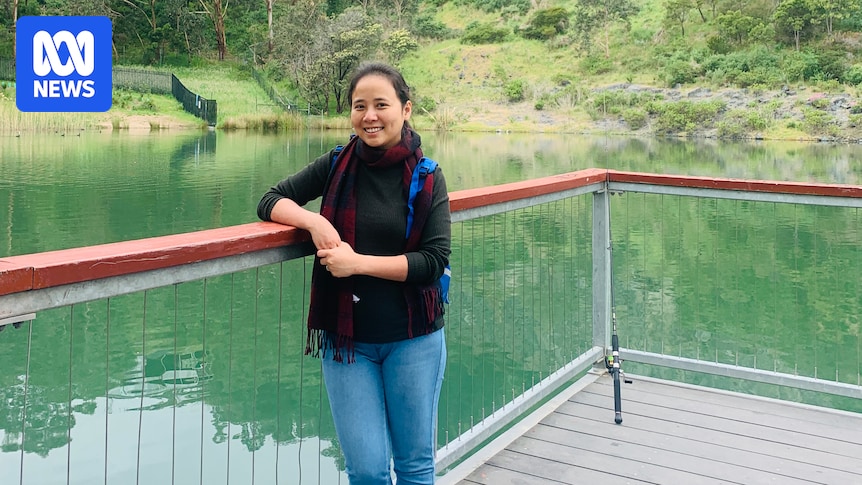
It's bad enough that Trang felt compelled to modify her name for her Australian identity documents; it also posed challenges when booking flights and returning to Vietnam, where officials correctly "understood my name as Trang, so they would question me as to why I put my name as Thị."
These are just a few examples ABC provides of non-Western naming structures:
![Some examples of different naming structures. Indonesian names: Wahyudi [Single given name (no family name)]. Vietnamese names: Lê [Family name] Thị [Thị/Văn (female/male)] Hiền Trang [Given name(s)]. Malay Muslim names: Sharifah [Given name] binti [bin/binti (son/daughter of)] Faisal [Father's given name]. Chinese names: Yao [Family name] Ming [Given name] (more common structore) / Ye [Family name] Qiu [Given or Generational name] Shu [Given name].](https://cdn.mymidnight.blog/a50abba8132a77191791390c3eb19fe7/2025/09/09af903c1d24a9b5a1edb0f36f1e796c.jpg)
For a deeper dive into naming conventions — with examples you'll recognize — I highly recommend this talk by Russell Keith-Magee at PyCon Australia:
How to Get the Sign-up Process Right
Figuring out when to use different permutations of my name is a question I deal with on a regular basis — at coworking spaces, at the bouldering gym, on remote work and travel trips. I love when organizations make an effort to ask what they should call me, rather than just use the name on my ID documents.
It's helpful to know when a business needs my legal name — for insurance or verification purposes — and when a preferred or chosen name will do. Most importantly, it's reassuring to know that a business will keep these names separate, and won't disclose a name I dislike to other customers.
Here's an example of a sign-up process that gets it right:
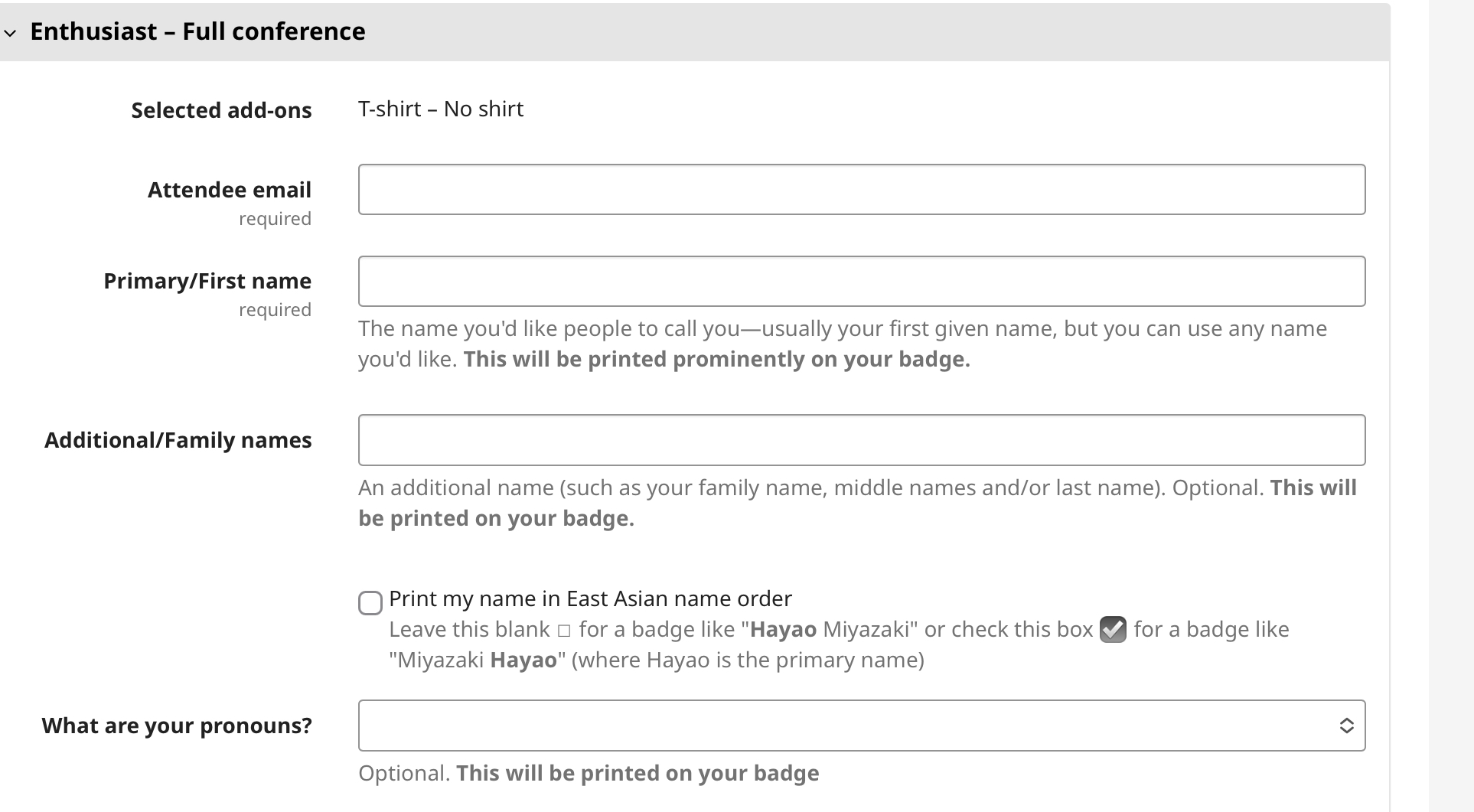
This is the signup form for PyCon AU, a queer-friendly tech conference that’s held every year in Australia. Although an earlier screen requests a full name for billing purposes, this form makes it clear that you can use any name you’d like people to call you. It states clearly how it will be used (“it will be printed prominently on your badge)” and that adding a middle or last name is optional. You can also choose to have your name printed in East Asian name order.
Here’s another one, in which a participant’s legal name is required:
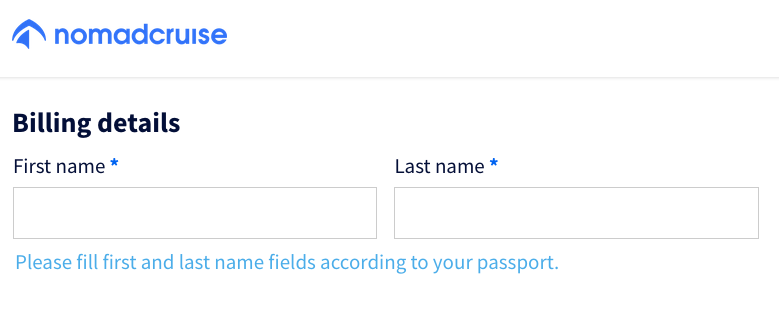

What works well about this form? I like that the request for a first and last name has specific criteria: "according to your passport". Otherwise, the customer might be wondering if it's appropriate to use their preferred name here. It's not perfect, since it still assumes customers have a first and last name, but at least it provides some parameters and a justification for them.
Secondly, the option to provide a preferred name gives participants control over how they're introduced to other participants. I'd still quibble with the use of the term "nickname," which minimizes how important this can be — particularly to queer people — but is still inclusive of both chosen and preferred names.
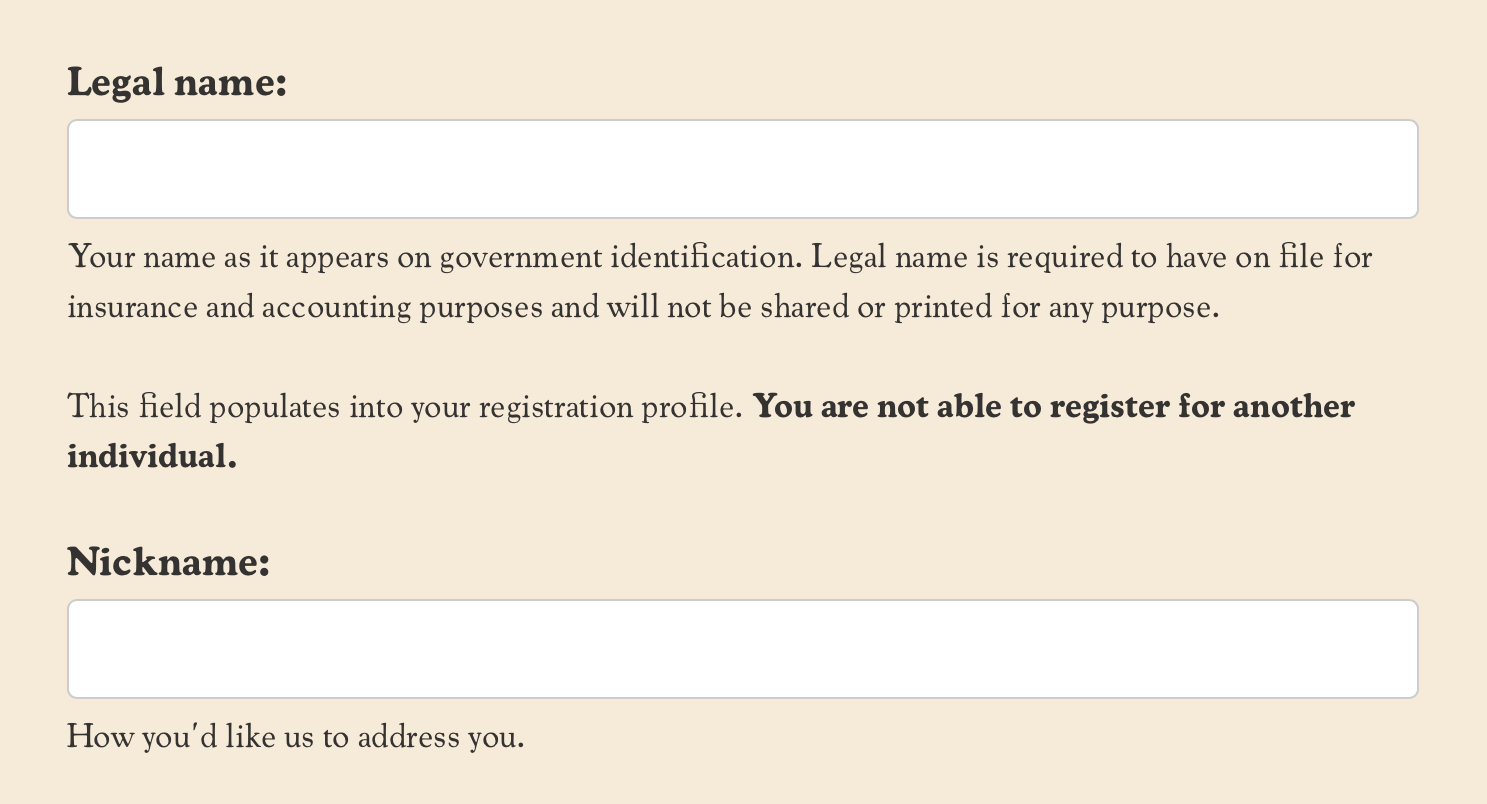
This signup form for PyConUS takes a similar approach, but goes one step further by explaining why they need your legal name and emphasizing that it won’t be “shared or printed for any purpose.” It does, however, make the same “nickname” faux-pas.
Using Your Preferred Name as a Digital Nomad
Traveling as a queer digital nomad can be challenging. We need to use our legal names to apply for visas and cross borders, but we still want to be called by our preferred or chosen name in as many places as possible.
Here are a few tips to ensure you have a pleasant travel experience:
- Advocate for yourself.
First, don't wait around for businesses to ask you how you want to be addressed. This is especially important on group trips, when being called by your preferred name can make or break the experience!
Before booking my first trip with NomaTribe, I asked them on a video call whether using my preferred name would be a problem. They assured me it wouldn't be, and did a great job of ensuring that my full legal name ended up on official documents, while using my preferred name in all other contexts.
2. Be prepared for accidental disclosure.
No matter how well-intentioned the leaders of your group, accidental disclosures can happen — especially when third-party vendors and tour guides are involved. You may be required to show your ID when visiting certain locations, and other participants may see your name on official documents.
On a recent trip, I overheard a tour guide address a participant by a name that I hadn't heard used before. She brushed it off: "That's my first name, but I go by [X]." No one made a big deal out of it or mentioned it again.
- Consider workarounds.
Unfortunately, some organizations which want to accommodate you may still be limited by their booking platforms or payment platforms. Sometimes this can result in clunky solutions, such as having to use your legal name on internal systems or put your preferred name in parentheses.
It's up to you to decide how flexible you want to be. Maybe it means printing out your own name badge instead of using the one with your legal name on it.
Or maybe — as with my experience at the coworking space — you'll decide that a business isn't the right fit for you and seek our more queer-friendly spaces.
Share Our Best Practices Infographic
Know any businesses that could do a better job of distinguishing between legal and preferred names? Download our free infographic and share it with them!
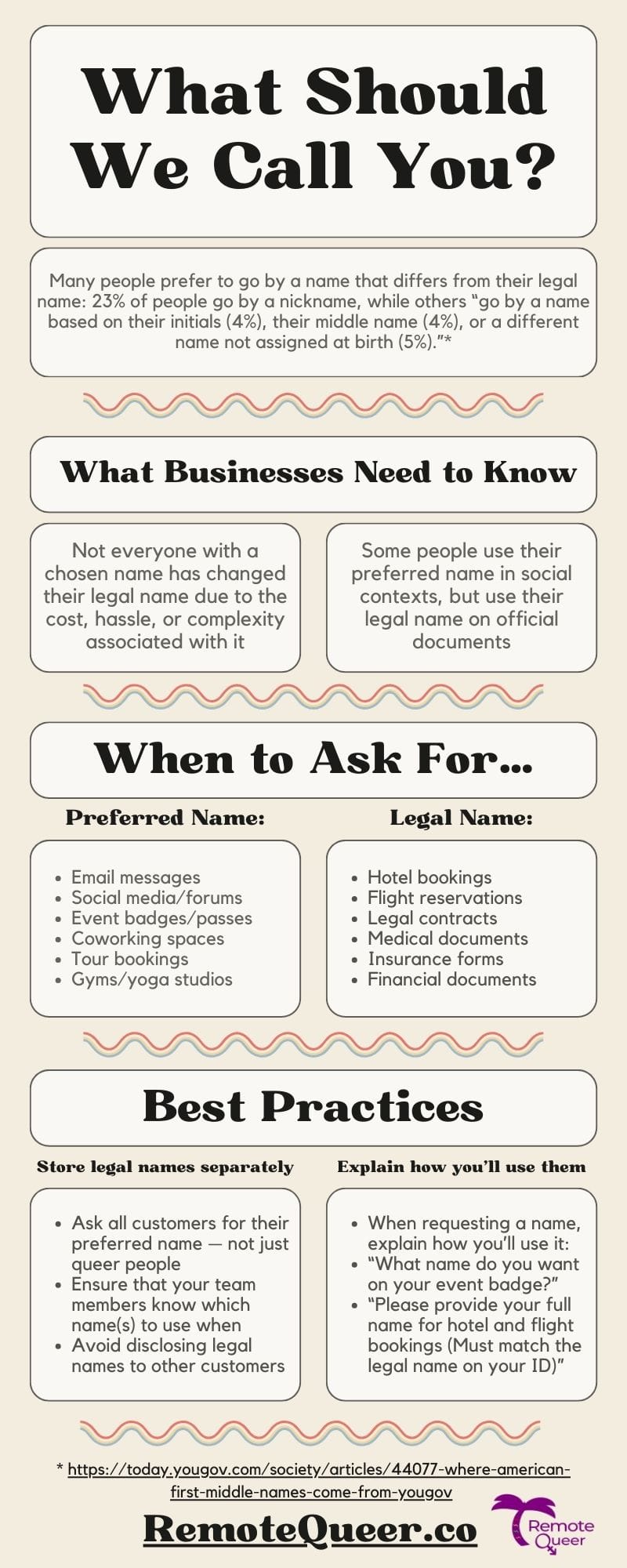
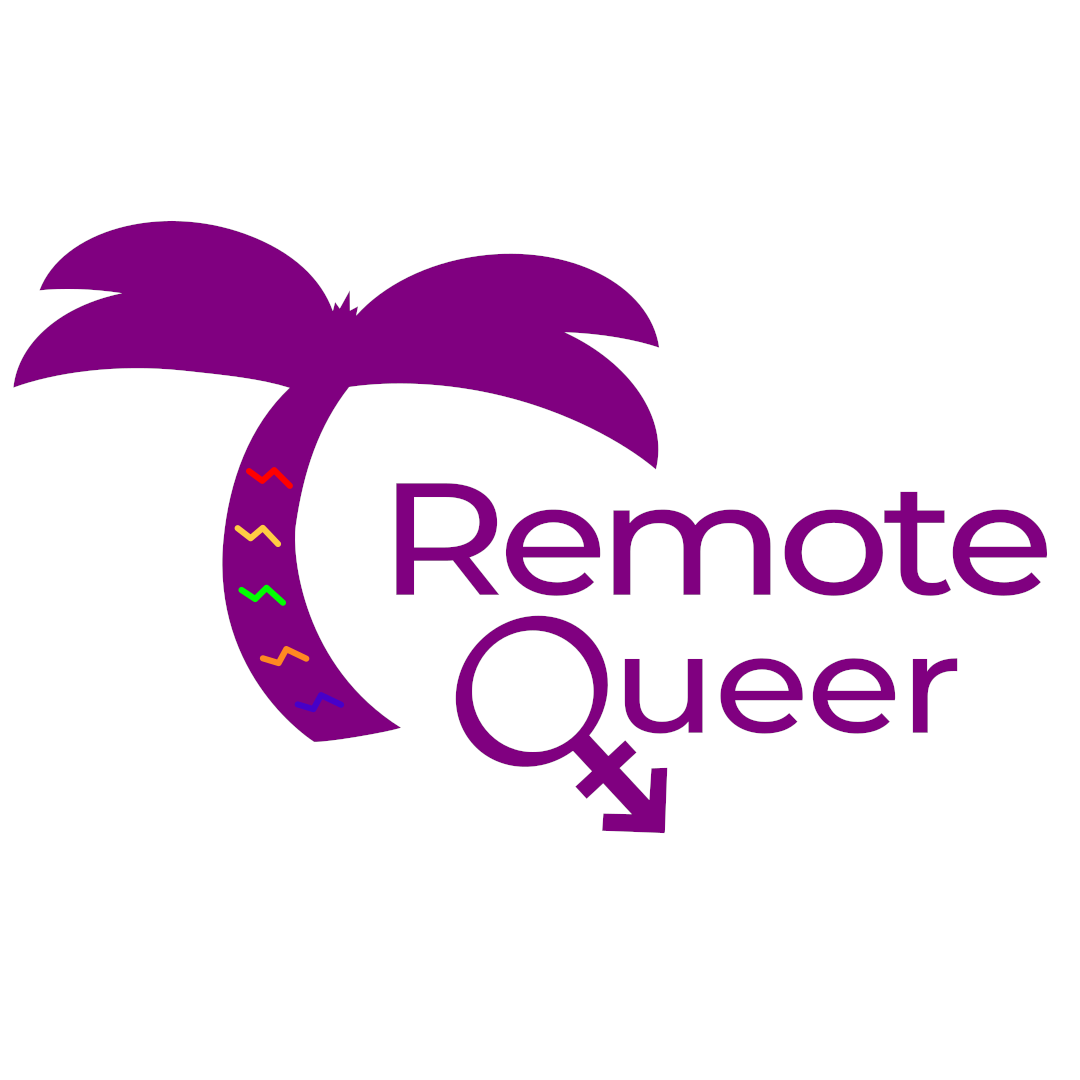


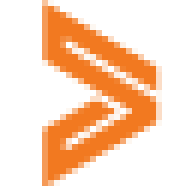

Discussion